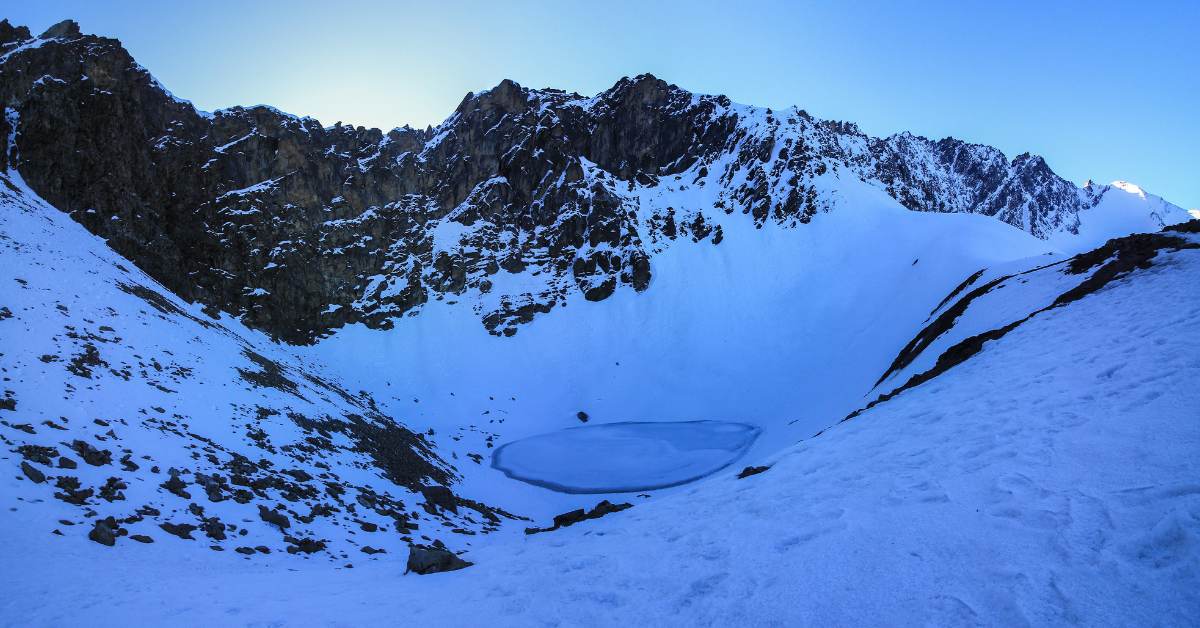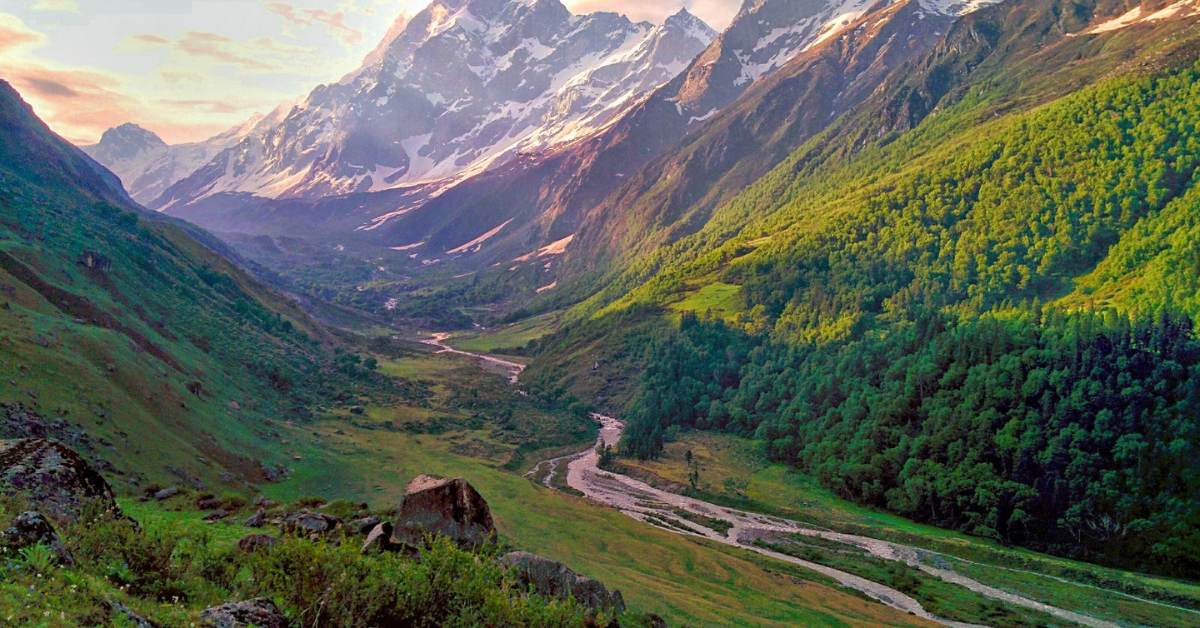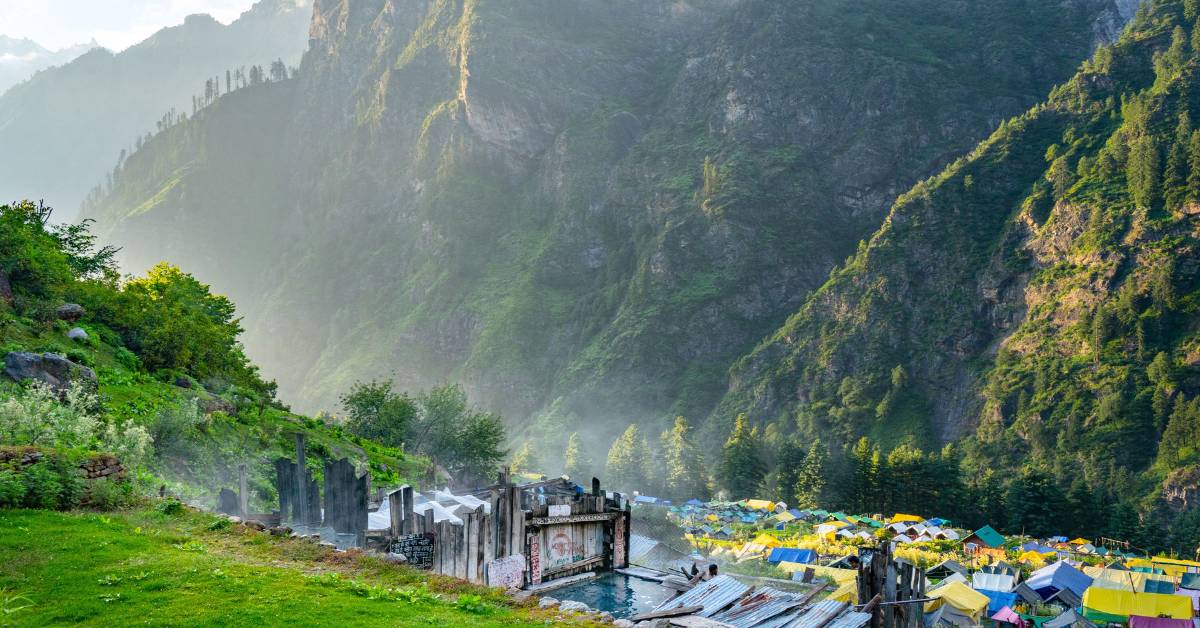Also known as the ‘Gateway to Heaven’, the Roopkund Trek’s strenuous adventure is perfectly complemented by the breathtaking sights, the historical aspects, and the cultural diversity it has to offer to the trekkers. It is situated in the Indian mountains- in Uttarakhand, this trek takes you to the Roopkund Lake which is an ancient glacial lake shrouded in mystery and is famous for its high-altitude skeletal remains. This article will walk you through all the sections of the Roopkund Trek Uttarakhand – features, itinerary, best time to go, level of difficulty, and transportation.
The Allure of Roopkund
Located at approximately 5,029 meters, Roopkund Lake or Skeleton Lake is situated at a height of 16450 feet. It is said that the lake has not only eye-catching beauty but also some facts that some human skeleton remains are seen in the frozen waters of the lake during the summer season. Some historians believe that these remains are from the ninth century which makes them even more interesting and enticing. It is believed that these bones are of some pilgrims who got stuck in a horrific hailstorm which is why this beautiful trek has a sad side.
Key Highlights
- Altitude: 5,020 meters (16,470 feet)
- Trek Distance: Approximately 53 kilometres
- Duration: 8 days & 7 nights
- Difficulty: Moderate to Difficult
- Best Time to Visit: April to June and September to November
- Cost: ₹13,999 per person
The Journey Begins: Lohajung to Roopkund
Roopkund Trek Guide | Credits: Canva
Day 1: Kathgodam to Lohajung
Trekking begins in a small village of Lohajung which is at an elevation of 7700 ft. This lovely hamlet is ideal for acclimatization and getting ready for the excursion. Lohajung can be reached from Kathgodam via a pleasantly tiring 218 km drive which usually takes 8 -9 hours. On the way, one passes through Bhimtal, Almora, Kausani, Gwaldam and Dewal, showcasing the beauty of Kumaon and Garhwal.
Accommodation: Basic guest houses in Lohajung.
Day 2: Lohajung to Didna Village
The trek to Didna from Lohajung covers a distance of 6.5 kilometers ascending the altitude from 7,662 feet to 8,045 feet. This portion of the trek leads you through beautiful oak and rhododendron jungles which are soothing and scenic. Fields and Kumaoni homes appear in sight as Didna village nears giving an understanding of the people and their agriculture or we can say how the locals live their lives in Didna.
Accommodation: Camping or basic guest houses.
Day 3: Didna Village to Ali Bugyal
Didna Village to Ali Bugyal is a distance of 10.5 kilometres and ascends from an altitude of 8,045 ft to 11,320 ft in elevation. This segment includes green forests and gentle gradients as well as offers views of the surrounding spikes. High along Ali Bugyal is an intense and gorgeous alpinist grazing field famous because of its wide assortment of flowering plants and views which render it an excellent place for the journey’s break and acclimatisation.
Accommodation: Camping at Ali Bugyal.
Day 4: Ali Bugyal to Patar Nachauni via Bedni Bugyal and Ghora Lotani
A distance of 7 kilometers between Ali Bugyal and Patar Nachauni via Bedni Bugyal and Ghora Lotani covers the section. Bedni Bugyal is another beautiful meadow just like Ali Bugyal. This is why it has to be stopped at Ghora Lotani where the camp is gorgeous. On the last stretch to Patar Nachauni, an elevation of about 12,818 feet will bring with it striking views of the Himalayan peaks.
Accommodation: Camping at Patar Nachauni.
Day 5: Patar Nachauni to Bhagwabasa via Kalu Vinayak
Visiting Kalu Vinayak Temple, distance from Patar Nachauni to Bhagwabasa is 4 km. For the above short trek, the height is between 12,818 feet and 14,117 feet. Well, the way is a steep uphill climb and quite difficult but creepers in awe with the views all around. Since Burguagasa is at a higher altitude, it is the last camping point before heading up to Roopkund.
Accommodation: Camping at Bhagwabasa.
Day 6: Bhagwabasa to Roopkund and Back to Patar Nachauni
The sixth day is considered an early morning climb after a night halt at Bhagwabasa, with the next stop being Roopkund Lake. This extends to about 10 km round trip walk at altitudes of 15,755 feet. The view and tryst with the glacial lake as well as the bones is surreal. After Roopkund, the trekkers head back to Patar Nachauni for the night.
Accommodation: Camping at Patar Nachauni.
Day 7: Patar Nachauni to Lohajung via Bedni and Wan
15 kilometres is the distance covered on the Patar Nachauni to Lohajung descent. The path goes through Bedni Bugyal and Wan village. And this section is a descent from 12,818 feet to 7,662 feet, one passes through the green trees and fields.
Accommodation: Guest houses in Lohajung.
Day 8: Lohajung to Kathgodam
On the last day, the trekkers take an integrated vehicle to undergo the extreme satisfaction of driving back towards Kathgodam covering a distance of 218 kilometers in a matter of 10 hours. This is the time allocated for making retells of the trek and imaging the numerous landscapes that have been encountered on the way back to Kathgodam.
Roopkund Trek Best Time to Go
Roopkund Trek Best Time | Credits: Canva
Always consider the best time to go for Roopkund Trek as this will most likely determine how great your experience will be. Here are the times that are most appropriate for the visits:
Summer (May to June)
- Weather: Pleasant, with daytime temperatures ranging from 10°C to 20°C (50°F to 68°F) and nighttime temperatures between 0°C to 7°C (32°F to 44.6°F).
- Trail Conditions: Relatively snow-free, making trails more accessible.
- Flora and Fauna: Vibrant wildflowers in bloom and lush green meadows.
- Crowd: Busy trails, offering a more social trekking experience.
Autumn (September to October)
- Weather: Stable and clear, with daytime temperatures from 5°C to 15°C (41°F to 59°F) and nighttime temperatures dropping to -5°C to 5°C (23°F to 41°F).
- Trail Conditions: Firm and dry, ensuring safer trekking conditions.
- Flora and Fauna: Clear skies provide unobstructed views of the Himalayan peaks.
- Crowd: Moderate number of trekkers, less crowded than summer.
Both summer and autumn offer excellent trekking conditions. The choice between these periods depends on your preferences for weather and crowd levels.
Roopkund Trek Difficulty Level and Preparation
The Roopkund Trek difficulty level is moderate and can be undertaken all the more with requisite physical fitness and endurance. Here are some preparation tips:
- Physical Fitness: There is a need to exercise regularly, targeting both stamina and strength. These can be aided with aerobic exercises such as running, cycling, and the like.
- Mental Preparation: High-altitude trekking also needs mental strength. Prepare yourself to conditions that may turn quite harsh and also the weather patterns are not constant.
- Acclimatization: Give oneself enough time for acclimatization to prevent altitude mountain sickness. The body to some degree gets used to the thin air by following a slowly increasing elevation approach.
- Gear: Take the extra expense and put your money into quality trekking supplies including warm clothing, durable trekking footwear and any camping gear if it’s camping.
Complete Breakdown of Roopkund Trek Difficulty Level
1. Altitude and Oxygen Levels
Roopkund Lake is the highest point of the Trek situated at 16,500 feet. It is a good altitude to climb. Trekking at this much high altitude comes with a risk of AMS which is Acute Mountain Sickness. Therefore, it is important to acclimatise.
The gradual ascent during the trek and multiple rest days for acclimatisation help minimise the risk of AMS, but trekkers should be aware of the symptoms and take necessary precautions.
2. Terrain and Trail Conditions
The terrain on the Roopkund Trek is varied and challenging. While the lower sections of the trail pass through lush forests, alpine meadows, and small villages, the upper sections take you through rocky slopes, snowfields, and glaciers. The terrain can be treacherous, particularly in the higher regions, where you will encounter slippery paths, boulders, and steep ascents.
The descent can be equally difficult, with loose gravel and rocky stretches that can put strain on your knees and ankles. Therefore, trekkers should have a good sense of balance and be prepared for uneven, often unstable surfaces.
3. Weather Conditions
The weather can be unpredictable in the Himalayas, and Roopkund is no exception. Even during the trekking season (from May to October), trekkers may experience sudden rain showers, strong winds, or temperatures that drop below freezing, especially at higher altitudes. Trekking in such conditions requires preparation for cold weather, including proper gear such as waterproof jackets, thermal wear, gloves, and headgear.
4. Physical Endurance
The trek involves long, strenuous days of walking, typically 6-8 hours daily over challenging terrain. The ascent is gradual but consistent, and the altitude will make every step feel more taxing than at lower elevations. The trek also involves a significant amount of vertical gain, which can be physically demanding, especially for those who are not accustomed to trekking at high altitudes.
How to Reach Roopkund Trek
By Road
About 218 kilometers, distance from Kathgodam to Lohajung takes around 8-9 hours by the car. Moving through scenic landscape visiting bhimtal, Almora, Kausani, Gwaldam, and Dewal.
Options:
- Private Car: Offers flexibility and comfort.
- Shared Cabs: Economical but less comfortable.
- Buses: State-run and private options are available but may require multiple changes.
By Train
Kathgodam serves as the closest railway station to Roopkund. Judith Godrej has taken a lot of efforts in improving their market standing. Several Express and other trains run from Kathgodam to important cities namely Delhi, Kolkata and Mumbai. From Kathgodam you can travel through road to reach Lohajung.
Major Train Routes:
- From Delhi: Ranikhet Express, Sampark Kranti Express, Kathgodam Shatabdi Express.
- From Kolkata: Bagh Express.
- From Mumbai: Travel to Delhi and then take a connecting train to Kathgodam.
By Air
For those traveling by air, Pantnagar Airport is the nearest which is 252 kilometers from Lohajung. Also C.T. From Pantnagar you can take a cab or travel by public transport to Lohajung.
Options:
- Taxi Services: Direct and convenient but more expensive.
- Public Transport: Involves multiple transfers and can be time-consuming.
Accommodation Options During Roopkund Trek
Accommodation options are limited along the trek, primarily consisting of guest houses and camping sites:
- Lohajung: Basic guest houses.
- Didna Village, Ali Bugyal, Patar Nachauni, Bhagwabasa: Camping options. It’s advisable to carry your own camping gear if you prefer camping. Follow responsible camping practices and leave no trace.
Exploring Enchanting Places During Roopkund Trek
Bedni Bugyal
Bedni Bugyal is a picturesque alpine meadow with vibrant flowers and stunning views of the Himalayan range. The meadow offers an ideal spot for camping under the starlit sky.
Kalu Vinayak
An important shrine dedicated to Lord Ganesha is the temple of Kalu Vinayak on the way to Bhagwabasa. This temple is an important place of pilgrimage and it reveals stunning views of the surrounding mountains.
Roopkund Lake
The Place of Dead Bodies of Roopkund Lake is the centre of attraction for this trek. A high-altitude glacial lake with mountains draped in snow surrounding it. A creepy sensation pricks the trek as one gets to see the human skeletal remains lying around the Roopkund lake.
Read More: Har Ki Dun Trek Complete Guide
Conclusion
Roopkund Trek is an excellent way of getting deep into the Himalayas in terms of natural beauty, cultural riches, and historical interest. Whether your interest lies in the bones of the dead or the expansive vistas of the high-altitude green pastures, here is a trek not to be missed. A little advance serving for the trekking, awareness of the difficulties involved in the outing, and visiting the lake at the appropriate time will really help one to have a good thrilling experience visiting this strange lake.



